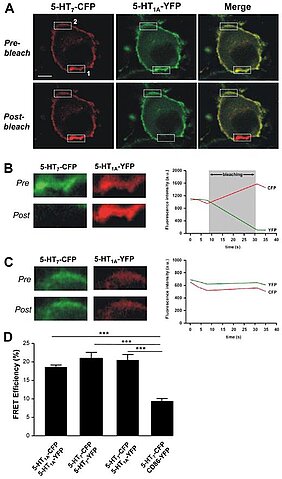Heterodimerization of serotonin receptors 5-HT1A and 5-HT7 differentially regulates receptor signalling and trafficking
01/01/2012Renner U, Zeug A, Woehler A, Niebert M, Dityatev A, Dityateva G, Gorinski N, Guseva D, Abdel-Galil D, Fröhlich M, Döring F, Wischmeyer E, Richter DW, Neher E, Ponimaskin EG (2012)
J Cell Sci. 125:2486-2499
Serotonin receptors 5-HT(1A) and 5-HT(7) are highly co-expressed in brain regions implicated in depression. However, their functional interaction has not been established. In the present study we show that 5-HT(1A) and 5-HT(7) receptors form heterodimers both in vitro and in vivo. Foerster resonance energy transfer-based assays revealed that, in addition to heterodimers, homodimers composed either by 5-HT(1A) or 5-HT(7) receptors together with monomers co-exist in cells. The highest affinity to form the complex was obtained for the 5-HT(7)-5-HT(7) homodimers, followed by the 5-HT(7)-5-HT(1A) heterodimers and 5-HT(1A)-5-HT(1A) homodimers. Functionally, heterodimerization decreases 5-HT(1A) receptor-mediated activation of G(i)-protein without affecting 5-HT(7) receptor-mediated signalling. Moreover, heterodimerization markedly decreases the ability of the 5-HT(1A) receptor to activate G-protein gated inwardly rectifying potassium channels in a heterologous system. The inhibitory effect on such channels was also preserved in hippocampal neurons, demonstrating a physiological relevance of heteromerization in vivo. In addition, heterodimerization is critically involved in initiation of the serotonin-mediated 5-HT(1A) receptor internalization and also enhances the ability of the 5-HT(1A) receptor to activate the mitogen-activated protein kinases. Finally, we found that production of 5-HT(7) receptors in hippocampus continuously decreases during postnatal development, indicating that the relative concentration of 5-HT(1A)-5-HT(7) heterodimers and, consequently, their functional importance undergoes pronounced developmental changes.






